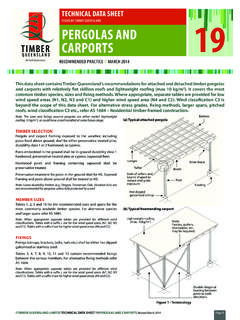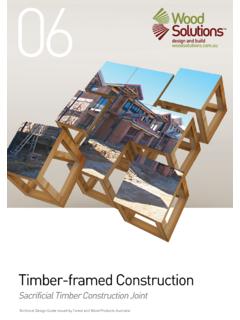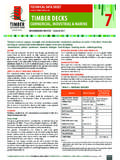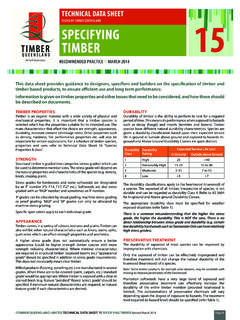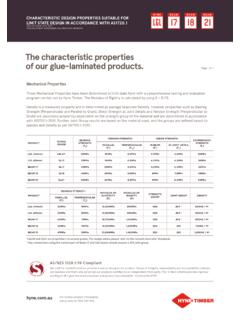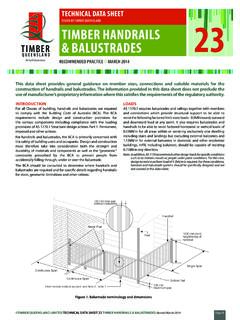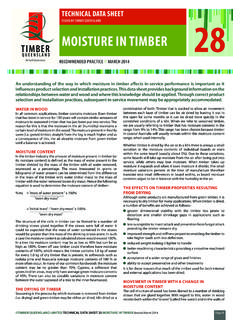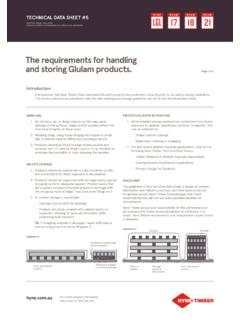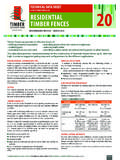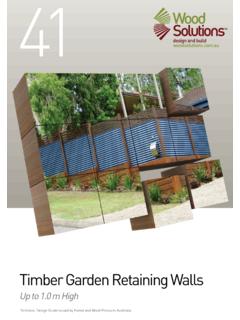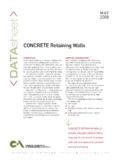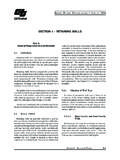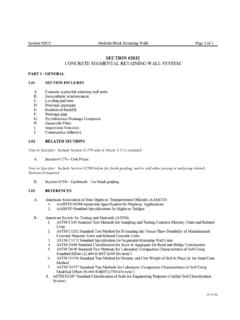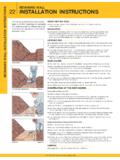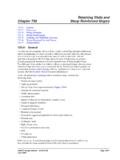Transcription of TECHNICAL DATA SHEET ISSUED BY TIMBER …
1 TIMBER QUEENSLAND LIMITED TECHNICAL DATA SHEET 9 TIMBER retaining WALLS Revised March 2014 Page 1 TIMBER is a preferred material for landscaping purposes. retaining walls in particular contribute significantly to the surroundings when constructed from TIMBER . The natural appeal and versatility of TIMBER is ideal for this purpose of this TECHNICAL Data SHEET is to provide sufficient detail to enable the correct design and construction of either log or sawn (or combinations) TIMBER retaining walls in residential document is intended to provide guidance for the design and construction of TIMBER retaining walls in residential settings and shall not be used where design or construction exceeds any of the following limits or there is any variation to the limitations stated in this Data SHEET including materials, soil conditions, drainage, surcharge (additional loads) or geometry of the retaining wall, a structural/ geotechnical engineer should be engaged to design the wall.
2 (i) Sloping GroundIf the ground in front of the wall is sloping then full ground support cannot be relied upon and larger posts with additional embedment will have to be used. If the slope is steeper than 10 (1 vertical to 6 horizontal) then a special design is required, and the tables herein shall not be used (See Figure 1).Inclining the ground behind the wall (backfill) produces more vertical load due to weight of backfill. This results in higher horizontal loads (horizontal loads deriving from vertical loads).If the ground behind the wall (backfill) has a slope steeper than 14 (1 vertical to 4 horizontal) the design tables are not applicable due to resulting higher gravity and live loads that will exceed the design loads assumed for the 1 - Sloping ground in front of and behind wall(ii) Permanent Structures (Existing or future)The horizontal force generated by the vertical load of permanent structures can have significant impact on the performance of retaining structures.
3 Permanent structures include (but are not limited to); buildings, pools, roads, parking areas, water tanks, general storage. If any such structures will impact within the zone of influence, as per Figure 3, the retaining wall design should be referred to a structural/geotechnical engineer. Fences of lightweight materials ( TIMBER , metal etc.) constructed on or above the wall do not impact on the design of the walls.(iii) Roads or RailwaysRoads and railways and areas adjacent are required to be designed for loads to accommodate the infrastructure and the vehicles over (trains, trucks etc.). These loads are significantly larger than those allowed for in this Data SHEET and therefore the Data SHEET shall not be used in these situations.(iv) Multiple retaining StructuresA retaining structure constructed within the zone of influence of another retaining structure will apply additional loads to the lower wall.
4 Terraced walls require specific design by structural/geotechnical enginners. This includes installing a new retaining wall above or below an existing retaining structure. The attached tables should not be used for designing any retaining structure with an existing or future retaining structure above or below such that the upper wall impacts within the zone of influence of the lower, as per Figure 3.(v) ServicesRetaining structures constructed in locations near services require particular mention. Generally the walls are required to be designed to impart no load on the services. Additionally, local authorities have specific requirements for different types of services, including minimum clearances. retaining walls to be constructed near service locations should be referred to the relevant local PRACTICE // MARCH 2014 TIMBER retaining WALLS FOR RESIDENTIAL APPLICATIONSTECHNICAL DATA SHEETISSUED BY TIMBER QUEENSLAND9 TIMBER QUEENSLAND LIMITED TECHNICAL DATA SHEET 9 TIMBER retaining WALLS Revised March 2014 Page 2(vi) DrainageDrainage of both the localised wall area and the surrounding topography should be considered during the planning process.
5 Drainage investigations should establish the local groundwater levels including sources, directions of lateral flow and seasonal or tidal variations. The possibility of seepage or surface run off should also be examined. Inadequate drainage can result in overloading of the wall or scouring of the footings, either of which may lead to wall failure. Where doubt exists, a structural/geotechnical engineer should be consulted.(vii) Poor Foundation MaterialThe foundation material assumed in design for this Data SHEET and attached tables is stiff clay. Stiff clay is unable to be molded. It is able to be indented only with strong downward pressure of alternative foundation materials are: Weathered rock ( shale) Dense sand/gravelIf the foundation material is not within this range, the tables in this Data SHEET shall not be used.(viii) Poor Backfill MaterialThe attached tables include three options for backfill materials.
6 These are: sand, sandy gravel and gravel. Alternative materials may result in wall failure due to swelling of backfill or lack of drainage. If the backfill material is not within the above range, the tables shall not be used. Alternative backfill material should be referred to a structural/geotechnical engineer.(ix) Consequence of Structural FailureThe designs contained in this Data SHEET assume Structural Classification 2 and 3 as per AS 4678, that is - Where failure would result in moderate damage and loss of services for walls over and Where failure would result in minimal damage and loss of access and where the wall height does not exceed , for walls under the proposed retaining wall location has adjacent structures or facilities with post disaster functions, or failure of the wall may result in significant damage or risk of life, a structural/geotechnical engineer should be may be used in sawn sizes approximating landscape sleepers or as logs where the round forms may be blended unobtrusively into the natural setting.
7 In addition, proprietary TIMBER crib wall systems are also minimum stress grade for sawn TIMBER shall be F7 for softwood and F14 for the retaining wall forms part of a landscape where plants are encouraged to soften the harder elements of construction. In this environment the possibility of insect and fungal attack is high. In-ground Durability Class 1 TIMBER species or plantation softwood TIMBER preservative treated to H5 should therefore be heartwood of naturally durable species (durability class 1) that are suitable for retaining walls include ironbark, grey gum, tallowwood, forest red gum and bloodwood. These species are also listed as being termite resistant in accordance with AS Provided that the outer layers of the log (sapwood) are removed or preservative treated to H5, these timbers will perform satisfactorily for more than 25 have a wide sapwood band that can be made highly durable with CCA, ACQ or copper azole preservative treatment.
8 H5 CCA treated softwood rounds have an expected service life of 50 years or treatment shall be in accordance with AS except that the maximum percentage of untreated heartwood in softwoods (durability class 4) shall not exceed 20% at any cross : Sawn softwood landscape sleepers may be available with incising to improve preservative penetration into the heartwood and durability information on species, durability & suitability for specific applications can be obtained from Construction Timbers in Queensland 2 - Log and sleeper retaining wallsFORCESR egardless of the construction material, it is worthwhile to understand the forces that have to be resisted so that they may be reduced to reasonable levels or allowed for in the wall vertical load of the soil, and whatever rests upon it, generates a horizontal force that the wall must resist. It follows that any increase in load must be allowed for at the design stage.
9 This would include future: increase in level or slope of the backfill temporary loads such as dumped materials or heavy vehicles permanent structures such as building foundations or swimming pools (both in and above-ground)If a typical house foundation is located within the stable zone (shown shaded in Figure 3) then it is outside the zone of influence and its presence will have a negligible effect on the stability of the wall. If this is the case, then the accompanying tables are valid, if otherwise refer to a structural/geotechnical engineer for a specific design. TIMBER QUEENSLAND LIMITED TECHNICAL DATA SHEET 9 TIMBER retaining WALLS Revised March 2014 Page 3 BATTERG ravitational forces cause the backfill to slide towards the wall. As it does so, it develops frictional forces on the sliding surface. (See Figure 4.) This significantly reduces the load to be resisted by the wall.
10 As a result, the retaining structure can be made lighter. The wall must move before the backfill can generate its own internal friction and so the wall is erected with a batter (leans back into the bank), so that when it rotates (pressure on wall will cause it to straighten up), it still appears battering of the face also assists in reducing the forces in several less obvious ways. Since the backfill moves horizontally during this soil creep, the surface of the soil will drop. Any paving system used here should be flexible such as masonry pavers or asphalt. - not concrete. If this lateral movement of the wall cannot be tolerated, then a stiffer wall must be designed for higher loads. It has to be emphasized that the posts are very highly stressed and that the use of undersized posts will cause excessive deflection and possibly wall vertical layer of free draining material must be placed immediately behind the wall to dissipate the build-up of groundwater which otherwise would add to the load carried by the structure.
